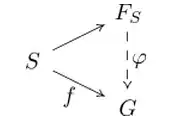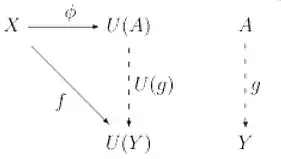I think your problems are due to the fact that you are identifying groups with their underlying sets.
As you've pointed in the first diagram you have to see $F_S$ as $U(A)$ and $G$ as $U(Y)$, where $U$ is a functor of type
$$U \colon \mathbf{Grp} \to \mathbf{Set}$$
in particular this is the forgetful functor, which sends every group in its underlying set.
To complete the translation you have to see $\varphi$ as $U(g)$.
Definition of free groups using the first diagrams can avoid the use of functors because they usually state separately that $G$ and $F_S$ should have to be the underlying sets of some groups and that $\varphi$ should be a function that is also a group homomorphism.
This statement is equivalent to requiring that there are some objects $A,Y \in \mathbf{Grp}$ and a morphism $g \in \mathbf{Grp}(A,Y)$ such that $U(A)=F_S$, $U(Y)=G$ and $\varphi=U(g)$.
Hope this explain how to see the first diagram as a special case of the second one.
For your second question, the wikipedia article you have linked has the answer to your question: suppose you have a functor between categories $\mathbf{C}$ and $\mathbf D$, let $U \colon \mathbf C \to \mathbf D$ be this functor, then a morphism from an object $X \in \mathbf D$ to the funtor $U$ is simply an object of the comma category $(\tilde X \downarrow U)$, while $\tilde X$ is the constant/selection functor for the object $X$. An initial morphism from $X$ to $U$ is just an initial object in the comma category $(\tilde X \downarrow U)$.
Edit: some specifications. The comma category $(\tilde X \downarrow U)$, where $U \colon \mathbf C \to \mathbf D$ is a functor and $X \in \mathbf D$, is the category having as set of objects the set $\bigcup_{Y \in \mathbb C} \mathbf D(X,U(Y))$, that is the set of all morphisms in $\mathbf D$ having $X$ as domain. Given two object is such category $u \colon X \to U(A)$ and $v \colon X \to U(B)$ a morphism $f \colon u \to v$ is a morphism $f \colon A \to B$ in $\mathbf C$ such that $v=U(f) \circ u$. The composition is inherited by $\mathbf C$ and so are the identities.
Hope this completely answer your question.

